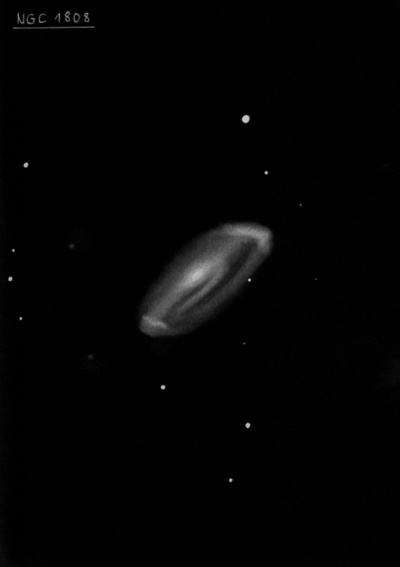
James Dunlop discovered NGC 1808 = D 549 = h2740 on 10 May 1826 and described "a faint nebula, about 2.5' long, and fully 1' broad, extended S.p. and N.f.; a very minute star near each extremity, not involved." He observed it on 2 occasions and his position was ~7' too far east. D 532 is probably a duplicate observation, but the position was off by 42' ESE.
John Herschel made two observations from the Cape. On 24 Dec 1835 he logged "B, L, lE, first gradually then psmbM. Transit missed, PD very rough" Two nights later he reobserved it and noted "B, E, 3' long, 1.5' broad; in a field strongly illuminated by the moon in her first quarter."
Joseph Turner sketched NGC 1808 with a very bright, elongated core on 19 Dec. 1876 using the 48" Great Melbourne Telescope (plate III, figure 26). See www.docdb.net/history/texts/1885osngmt________e/lithograph_m_3_26.php)
200/250mm - 8" (1/1/84): fairly bright, elongated NW-SE, moderately large, bright core. Similar in size to NGC 1792 but slightly fainter.
300/350mm - 13.1" (2/20/04 - Costa Rica): this 105x this striking starburst galaxy appeared bright, large, very elongated 4:1 NW-SE, 5'x1.3'. The glow is sharply concentrated with a well-defined 20" core that brightens to a stellar nucleus. There appears to be an irregular extension at the northwest end that brightens and is offset to the major axis [on photos this corresponds with the start of a spiral arm that is attached at the north edge of the NW end of the galaxy]. At 166x, the halo is irregular and mottled. Brightest in a group (LGG 127) along with NGC 1792 40' SW and the galaxies may have experienced a tidal interaction in the past.
400/500mm - 17.5" (1/31/87): bright, fairly large, small elongated core, long thin arms 4:1 NW-SE. A mag 14 star is off the NW end. This is a very pleasing galaxy.
Notes by Steve Gottlieb